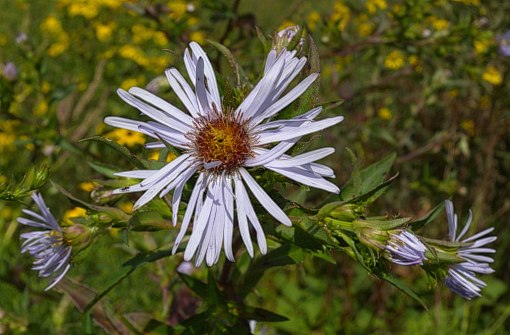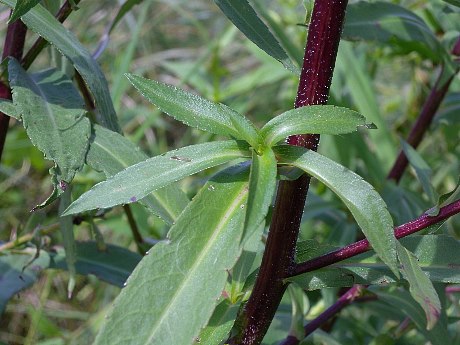Description: This perennial wildflower is 1½–6' tall, branching occasionally along the upper half of its length. The rather stout stems are light green to reddish purple (often the latter), terete to slightly grooved, and evenly covered with stiff spreading hairs. The alternate leaves are up to 6" long and 1¾" across, becoming gradually smaller along the upper half of each plant; they are narrowly lanceolate to lanceolate with poorly defined remote teeth along their margins. The leaves are yellowish green, medium green, or purple (sometimes the latter color during the fall); they are usually glabrous, except for some hairs along the central veins of their lower sides. Most leaves clasp the stems, although some of the smaller upper leaves are sessile.

The central stem
terminates in a panicle of flowerheads; some lateral stems may produce
smaller panicles of flowerheads. The branches of each panicle are
ascending and usually hairy. Along these branches, there are
linear-lanceolate leafy bracts up to 1" long. The outer branches
terminate in flowerheads about ¾–1¼" across, consisting of 30-50 ray
florets and a similar number of central disk florets. The petal-like
rays are usually lavender, pale blue-violet, or purple (less often
white); they are widely spreading and very slender. The tubular disk
florets are 5-lobed; they are initially yellow, but later become dull
red. At the base of each flowerhead, there are several overlapping
bracts that are linear in shape, green, and hairless; they are rather
loosely assembled around the base of the flowerhead and slightly
spreading. The blooming period occurs from late summer into the fall
and lasts about 2 months. Both disk and ray florets are fertile. The
florets are replaced by bullet-shaped achenes about 1.5 mm. long that
have small tufts of white hair; they are distributed by the wind. The
root system is fibrous and short-rhizomatous, sometimes forming a small
caudex on older plants.
Cultivation:
The preference is full or partial sun and wet to moist conditions. The
soil should contain some organic material to retain moisture and it
should be reasonably fertile. Sometimes, the leaves become diseased and
rather battered in appearance by the end of the year; the lower leaves
may turn brown and fall off in response to droughty conditions. The
size of individual plants can be highly variable.
Range & Habitat:
The native Swamp Aster is occasional in the northern half of Illinois,
while in
the southern half of the state it is uncommon or absent. Habitats
include soggy thickets along streams, open swamps, fens and calcareous
seeps, sedge meadows, and other wetlands. Swamp Aster is often found in
higher quality wetlands where the native flora is still intact. It is
primarily a boreal species that is found around the Great Lakes and
other cool areas.
Faunal Associations:
The nectar and pollen of the flowerheads attract a wide variety of
insects, including honeybees, bumblebees, other miscellaneous bees,
various wasps, bee flies and other miscellaneous flies, and various
butterflies, skippers, and moths. The oligolectic bees,
Andrena asteris and Andrena hirticincta,
suck nectar and collect pollen from the flowerheads of Swamp Aster.
Other insects feed on the foliage, suck plant juices, bore through the
stalks and roots, or gnaw on the flowers and developing seeds of Symphyotrichum
spp. (asters). These species include Microrhopala
xerene and other leaf beetles, several aphids (mostly
Uroleucon spp.),
the stinkbug Trichopepla semivittata,
the leafhopper Macrosteles quadrilineatus, the
plant bug Plagiognathus cuneatus, Poecilocapsus
lineatus (Four-Lined Plant Bug), Lygus lineolaris
(Tarnished Plant Bug), and the larvae of Calycomyza humeralis
(Aster Leafminer Fly). In addition to these insects, a large number of
moth caterpillars feed on asters (see the Moth Table
for a listing of these species), as do the caterpillars of the
butterflies Chlosyne nycteis (Silvery Checkerspot)
and Phyciodes tharos (Pearl Crescent). Among
vertebrate animals, the Wild Turkey eats the seeds and leaves
occasionally, while the White-Tailed Deer and Cottontail Rabbit browse
on the foliage.
Photographic Location:
A low area along a pond at Weaver Park in Urbana, Illinois.

Comments: Except for Symphyotrichum novae-angliae (New England Aster), Swamp Aster has larger flowerheads than other Symphyotrichum spp. (asters) in Illinois and its flowerheads usually have more rays (about 30-50). It is a pretty hefty plant that is about as tall as New England Aster. This latter species has glandular hairs along its stems and its leaves are less shiny than those of Swamp Aster. Swamp Aster is divided into two varieties or subspecies: the typical variety/subspecies has evenly hairy purple stems, while variety/subspecies firmus (or lucidulous) has light green stems that are either hairless or the hairs are arranged in lines; sometimes the color of the stems is not reliable in making this distinction. The rhizomes of the typical variety/subspecies are supposed to be short, while the rhizomes of variety/subspecies firmus (or lucidulous) are supposed to be long. Some authors (e.g., Mohlenbrock, 2014), divide Swamp Aster into two separate species: Symphyotrichum puniceum and Symphyotrichum firmum. They have a similar distribution and are about equally common in Illinois. The preceding descriptive information and photos apply to Symphyotrichum puniceum puniceum. A scientific synonym of Swamp Aster is Aster puniceus.